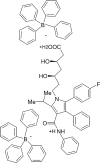Performance evaluation of a novel potentiometric membrane sensor for determination of atorvastatin in pharmaceutical preparations
- PMID: 24523744
- PMCID: PMC3920707
Performance evaluation of a novel potentiometric membrane sensor for determination of atorvastatin in pharmaceutical preparations
Abstract
A novel potentiometric ion-selective PVC membrane sensor for analysis of atorvastatin (AT) in pharmaceutical preparations based on atorvastatin-(tetraphenyl borate), (AT-(TPB)2) as sensing element, tetraphenyl borate as additive and tris-2-ethyl-hexyl phosphate (TOP) as plasticizer solvent was prepared. The electrode shows a good Nernestian response over the concentration range of 0.09-5586 μg mL(-1)of AT with slope of 30.1±0.1 mV/decade and limit of detection0.056μg mL(-1).The response time of sensor is fats (less than 10 sec) and could be used for about one month in the pH range of 4.5-8.0. The electrode exhibit good selectivity for the AT in the presence of large amount of co-drugs and inorganic cations. The method is precise and accurate with mean relative standard deviation of <2%.Atorvastatin is determined successfully in several tablets by the proposed membrane.
Keywords: Analysis of pharmaceutical preparation; Atorvastatin; PVC membrane; Potentiometric sensor.
Figures






Similar articles
-
Comparative Study of PVC-Free All-Solid-State, PVC Membrane, and Carbon Paste Ion-Selective Electrodes for the Determination of Dapoxetine Hydrochloride in Pharmaceutical Formulation.J AOAC Int. 2016 Nov 1;99(6):1499-1504. doi: 10.5740/jaoacint.16-0089. Epub 2016 Sep 1. J AOAC Int. 2016. PMID: 27590599
-
All-Solid-State, PVC Membrane, and Carbon Paste Ion-Selective Electrodes for Determination of Donepezil Hydrochloride in Pharmaceutical Formulation.J AOAC Int. 2017 Sep 1;100(5):1414-1419. doi: 10.5740/jaoacint.16-0299. Epub 2017 Apr 18. J AOAC Int. 2017. PMID: 28421986
-
Potentiometric determination of famotidine in pharmaceutical formulations.J Pharm Biomed Anal. 2002 Jun 20;29(1-2):247-54. doi: 10.1016/s0731-7085(02)00024-9. J Pharm Biomed Anal. 2002. PMID: 12062684
-
Potentiometric determination of moxifloxacin in some pharmaceutical formulation using PVC membrane sensors.Chem Cent J. 2014 Sep 17;8(1):59. doi: 10.1186/s13065-014-0059-y. eCollection 2014. Chem Cent J. 2014. PMID: 25342965 Free PMC article.
-
Synthesis of a new oxime and its application to the construction of a highly selective and sensitive Co(II) PVC-based membrane sensor.Anal Sci. 2004 Mar;20(3):531-5. doi: 10.2116/analsci.20.531. Anal Sci. 2004. PMID: 15068300
Cited by
-
Computational aided-molecular imprinted polymer design for solid phase extraction of metaproterenol from plasma and determination by voltammetry using modified carbon nanotube electrode.Iran J Pharm Res. 2014 Spring;13(2):417-29. Iran J Pharm Res. 2014. PMID: 25237337 Free PMC article.
-
Effects of Atorvastatin on Negative Sign in Chronic Schizophrenia: a Double Blind Clinical Trial.Iran J Pharm Res. 2015 Fall;14(4):1269-74. Iran J Pharm Res. 2015. PMID: 26664396 Free PMC article.
-
Potentiometric Electronic Tongue for the Evaluation of Multiple-Unit Pellet Sprinkle Formulations of Rosuvastatin Calcium.Materials (Basel). 2024 Oct 14;17(20):5016. doi: 10.3390/ma17205016. Materials (Basel). 2024. PMID: 39459720 Free PMC article.
References
-
- Lea AP, Mc Tavish D, Atorvastatin A review of its pharmacology and therapeutic potential in the management of hyperlipidaemias. Drugs. 1997;53:828–847. - PubMed
-
- Ness GC, Chambers CM, Lopez D. Atorvastatin action involves diminished recovery of hepatic HMG-CoA reductase activity. J. Lipid. 1998;39:75–84. - PubMed
-
- Conde K, Pineda G, Newton RS, Fernandez ML. Hypocholesterolemic effects of 3-hydroxy-3-methylglutaryl coenzyme A (HMG-CoA) reductase inhibitors in the guinea pig: Atorvastatin versus simvastatin. Biochem. Pharmacol. 1999;58:1209–1219. - PubMed
-
- Nawrocki JW, Weiss SR, Davidson MH, Sprecher DL, Schwartz SL, Lupien PJ, Jones PH, Haber HE, Black DM. Reduction of LDL cholesterol by 25% to 60% in patients with primary hypercholesterolemia by atorvastatin, a new HMG-CoA reductase inhibitor. Arterioscler. Thromb. Vasc. Biol. 1995;15:678–682. - PubMed
LinkOut - more resources
Full Text Sources
